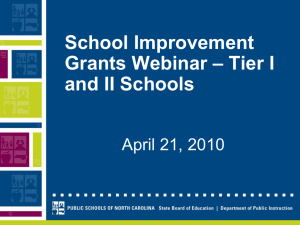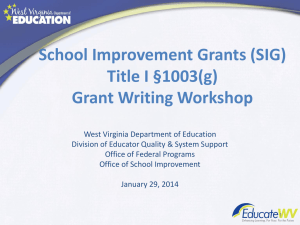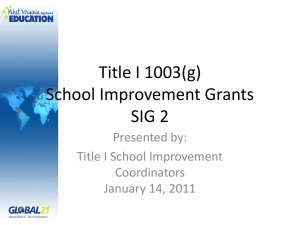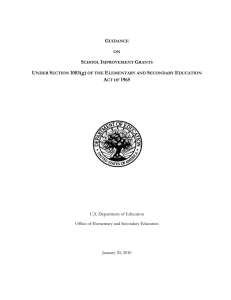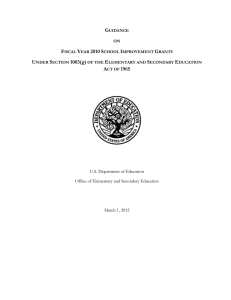Federal Program Monitoring and Support Division Charlotte Hughes, Director
advertisement
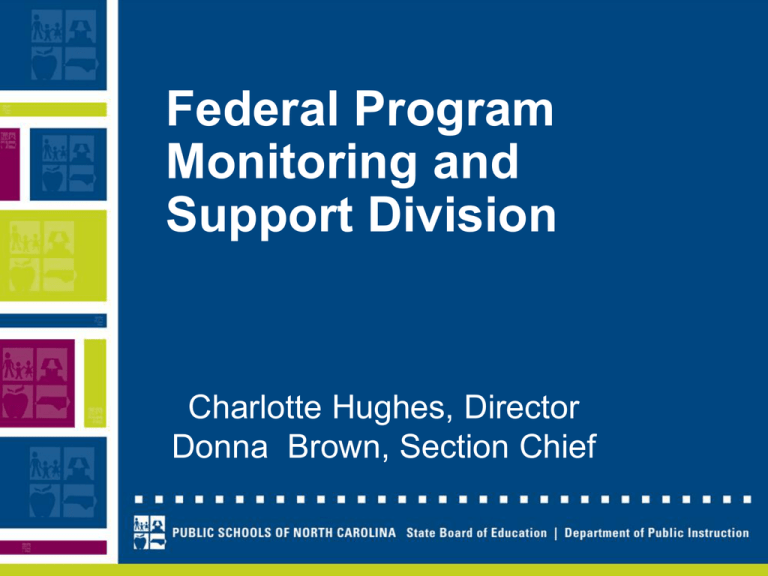
Federal Program Monitoring and Support Division Charlotte Hughes, Director Donna Brown, Section Chief Federal Program Monitoring and Support Division • $437,000,000 •2 in federal funds sections Federal Program Monitoring – Support Services – • 23 full-time staff members • 18-20 contract staff • 19 programs Federally-Funded Programs • • • • • • • • • Title I, Part A Migrant Education Program School Improvement Grants Neglected and Delinquent Programs 21st Century Community Learning Centers Rural Low-Income Schools Small Rural Schools Achievement Program McKinney-Vento Homeless Education Program Safe and Drug Free Schools Federal Requirements • • • • • • • • • • Title I LEA/School Improvement Federal Teacher Loan Forgiveness Program Comparability Reporting Ed-Flex Authority Supplemental Educational Services (SES) Consolidated Federal Data Collection System (CFDC) MSIX Initiative Persistently Dangerous Schools Profile and Performance Information Collection System (PPICS) Committee of Practitioners (COP) State Requirements • Textbook Adoption • Alternative Learning Programs • Discipline Data Collection • Dropout Data Collection • School Safety Roles and Responsibilities Approve Applications for Entitlement Funding • Facilitate Competitive Grants • Conduct Monitoring (Programs and Fiscal) • Conduct Program Quality Reviews • Provide Technical Assistance • Process Data Collection and Reporting • Support Agency-wide Initiatives (e.g., State-wide System of Support) • Title I, Part A • 2010-11 – – – – $378,000,000 115 local education agencies and 47 charter schools 1,297 schools served 1,256 operate schoolwide programs School Improvement grants 1003(a) • School Improvement Grants (SIG) 1003(g) • Background on SIG Purpose: • Raise student achievement in the Nation’s persistently lowest-achieving schools Awards: $3.5 billion in FY 2009 Award Structure: • Formula grants to States • Competitive subgrants from States to LEAs Persistently LowestAchieving (PLA) Schools Tier I Schools – – Lowest 5% Title I Schools in School Improvement based on proficiency scores or Title I high schools with a graduation rate below 60% Tier II Schools – – Lowest 5% Title I eligible, but not served secondary schools based on proficiency scores or Title I eligible, but not served high schools with a graduation rate below 60% 2010-11 SIG Schools • 18 LEAs • 24 SIG schools • $63,367,811 allocated • $980,000 to $6,000,000 per school for three years 2011-12 SIG Schools FY10 – $ 37,000,000 • Available through September 2014 with a waiver • 31 LEAs • 45 persistently lowest-achieving schools • Estimated School Awards • $50,000 to $2,000,000 per school renewable for up to three years • Funds may only be used for SIG schools • LEA must select 1 of 4 intervention models • LEA must demonstrate capacity to fully implement SIG model(s) SIG Intervention Models TURNAROUND Replace Principal Rehire up to 50% of staff RESTART CMO or EMO hired to run the school TRANSFORMATION CLOSURE Replace Principal LEA closes school New teacher evaluation system Students enrolled in higher performing school Extended learning time Extended learning time Ensure use of data Ensure use of data Provide jobembedded PD Provide jobembedded PD Research-based instructional programs and standards that are vertically aligned Research-based instructional programs and standards that are vertically aligned Capacity Reviews • On-site monitoring visits – Capacity to support implementation plan – Progress toward key indicators – Progress toward measurable goals Capacity Building • Teacher Leadership program • Cambridge Education • Assessment for Learning – 24 teacher leaders identified – 3-day training in December – 20-25 LEA participants receive sessions within LEAs SIG Planning • Conduct needs assessment • Communicate with key stakeholders • Collaborate with external partners LEA Application Design and implement interventions consistent with the final requirements; • Recruit, screen, and select quality external providers; • Align other resources with the interventions; • Modify practices or policies to implement the interventions fully and effectively; and • Sustain the reforms after the funding period ends. • Evaluation Criteria • Analysis of needs for each Tier I and Tier II school • Action steps to fully implement the selected intervention • Capacity for supporting interventions models • Budget with sufficient funds to implement Tier I and Tier II Reporting Requirements Intervention model the school used; • Number of minutes within the school year; • Average scale scores on State assessments; • Number and percentage of students completing advanced coursework earlycollege high schools, or dual enrollment classes; and • Teacher attendance rate. • NCDPI Resources • Application materials • SIGnificant Points newsletter • http://www.ncpublicschools. org/program-monitoring/



